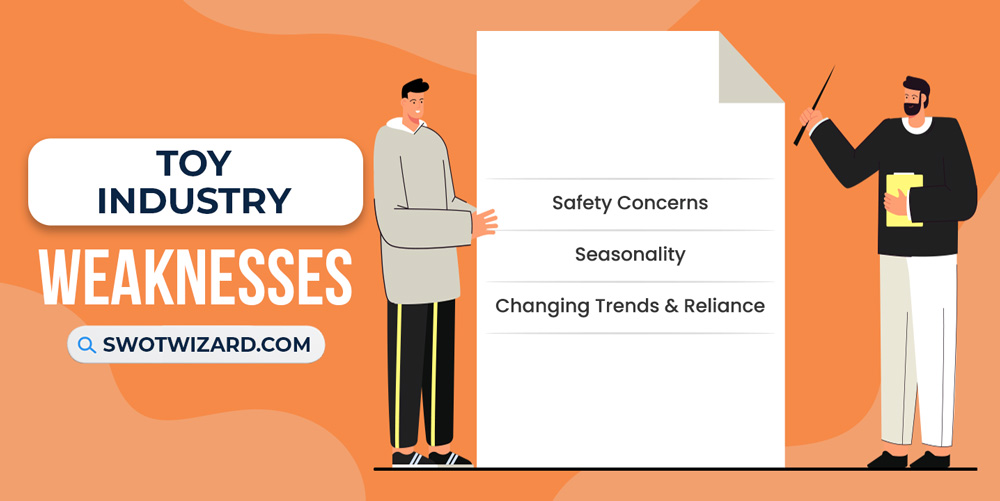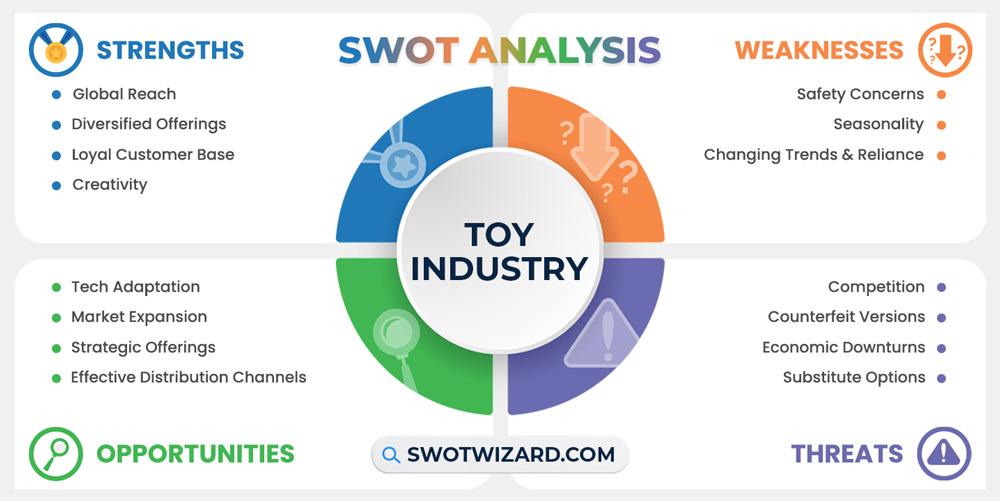The toy industry has reached every home on Earth, whether for kids or adults. Some of us grow up with lots of toys, and some find a passion for toys and start collecting Lego sets or Hot Wheels until they die. With millions of stories to tell about toys, we will get to know more about the business side of the industry in this toy industry SWOT analysis.
Toy Industry Overview
One of the earliest known toys is believed to be the “ball,” which dates back to ancient civilizations. After that, the toy industry revolutionized in many ways and became one of the major industries worldwide. The global toy industry is estimated at over $308.2B annually, and leading companies like Mattel, Hasbro, and LEGO maintain market dominance, catering to billions.
Competitors in Toy Industry
Mattel | Hasbro | Lego | Toys”R”Us | Fisher-Price | Jakks Pacific | Hot Wheels | Nerf | Spin Master
Did You Know?
With over 8.5 billion produced from 1975 to 2023, LEGO minifigures outnumber humans on Earth.
Strengths – Toy Industry SWOT Analysis

Global Reach: Major toy companies, like LEGO, have worldwide production and distribution networks and have a presence in over 140 countries. Lego products are sold overall over the globe, with manufacturing facilities worldwide and reported revenue of $9.2B in 2022, showcasing the industry’s ability to capture international markets and adapt products for diverse cultures.
Diversified Offerings: Leading toy makers have broad brand portfolios spanning demographics, interests, and price points. Mattel owns Barbie, Hot Wheels, Fisher-Price, and more, ensuring a broad consumer appeal and reducing market concentration risks. As a result, the different diversification techniques allow revenue generation across segments and insulate against category declines.
Loyal Customer Base: Iconic toy brands enjoy strong nostalgia and multigenerational appeal and foster enduring customer connections. Hasbro’s Transformers franchise has spanned comics, cartoons, movies, and toys since 1984, cultivating a loyal following for decades, and these connections are translating into consistent sales.
Creativity: Toys tap into developmental needs, and toy designers continuously innovate with creative new play patterns, mechanics, and technologies. Disney’s imaginative storytelling, beyond movies into toys, showcases how creativity drives innovation and keeps the industry vibrant and relevant. Besides, Lego launched coding robots for STEM education, showcasing the company’s knack for blending education with engagement.
Weaknesses – Toy Industry SWOT Analysis

Safety Concerns: Toy recalls due to safety issues can severely damage brands, Mattel recalled over 20M toys containing hazardous magnets or lead paint in 2007. On the other hand, new and complex electronics or materials raise potential hazards, leading to further severe incidents. All these can damage consumer trust and incur significant costs for the company, underscoring the need for rigorous quality control.
Seasonality: Toy sales are highly concentrated around the winter holiday, with around 40% of USA toy sales occurring in the last quarter of the year. As a result, it spikes production costs and strains retail inventory management during that time, making sustained profitability challenging.
Changing Trends & Reliance: Toy preferences can shift rapidly as new products arise and demographics evolve. If we look at the data from the past decade, traditional toy sales have declined with the rise of video games and electronics. Besides, Walmart alone accounted for around 21% of Mattel’s sales in 2022, saying a lot about reliance on mega-retailers and their bargaining power.
Opportunities – Toy Industry SWOT Analysis

Tech Adaptation: Incorporating emerging technologies like augmented reality, artificial intelligence, and the Internet of Things into toys can reinvigorate traditional play patterns. Nintendo’s Pokemon Go mobile game leveraged AR and geolocation, creating a new style of interactive gameplay. Similarly, Lego’s integration of augmented reality with their “Hidden Side” sets provides an immersive gaming experience. Global sales of AR toys were valued at over $10B in 2022, showcasing a growing demand for tech-infused toys.
Market Expansion: Population and income growth in developing countries is expanding the global middle class. China is already the second largest toy market after the USA, which tailors products and marketing to new demographics and regions can find significant untapped opportunities. Besides, the global toy market is expected to reach $131.19B by 2025, with Asia-Pacific leading this expansion.
Strategic Offerings: Licensing deals with entertainment franchises, celebrities, influencers, and corporate brands allow toy makers to retain core strengths while expanding appeal. Hasbro’s collaboration with popular franchises like Marvel and Star Wars or Lego’s Starbucks set collaborations is one of the reasons behind Hasbro’s massive increase in revenue after the collaboration.
Effective Distribution Channels: Omnichannel retail strategies, including company-owned stores, direct-to-consumer e-commerce, and social commerce, provide more options to reach customers. As for e-commerce, Amazon has become a primary distribution channel for many toy companies, with 38% of USA toy sales occurring online in 2022. Besides, Hasbro acquired Entertainment One for content and its 80+ retail outlets, enhancing margins and customer data.
Threats – Toy Industry SWOT Analysis

Competition: With low barriers to entry for niche players, the industry is becoming very competitive internally. Established brands compete against lower-cost imitators and new entrants. Data indicates that the top five companies control over 50% of the global toy market, fostering fierce competition for the remaining share.
Counterfeit Versions: Knock-off versions of popular toys flood the market, often with inferior quality and safety standards. It is estimated Hasbro loses up to $360M annually from counterfeit toys, many originating from China. Besides, the OECD estimates that counterfeit goods account for 3.3% of global trade, with the toy sector being a significant contributor.
Economic Downturns: Toys are not necessary or crucial items like other household products, and toys are discretionary purchases often reduced during recessions. During the 2008 financial crisis, toy sales declined as consumers cut back on discretionary spending, and as a result, Mattel’s net sales dropped 6% during that time.
Substitute Options: Electronic devices and digital entertainment such as video games, mobile apps, streaming content, and electronics offer alternatives to traditional toys, capturing children’s attention. If we look at the data, American children aged eight and underspent an average of 2 hours and 24 minutes per day on screen media in 2022, potentially diverting their interest from physical toys.
[Bonus Infographic] SWOT Analysis of Toy Industry

Recommendations for Toy Industry
As there are too many threats to the industry, all stakeholders should come together to solve and tackle the issues strategically.
- Invest in research and development to incorporate emerging technologies like augmented reality, artificial intelligence, and the Internet of Things into toys.
- Pursue partnerships and localized product development to access fast-growing toy markets like China, India, and Eastern Europe.
- Seek licensing deals, co-branding, and entertainment collaborations to leverage existing franchises and brands.
- Adopt an omnichannel sales strategy encompassing owned e-commerce platforms, retail outlets, social commerce, and online marketplaces.
Frequently Asked Questions (FAQs)
Which country sells the most toys?
China sells the most toys.
What is the number 1 toy brand?
Lego is the number 1 toy brand.
Final Words on Toy Industry SWOT Analysis
The Toy Industry is at a pivotal juncture, facing challenges and opportunities. While competition, counterfeit products, economic fluctuations, and digital alternatives pose threats, embracing technology, expanding into emerging markets, offering diverse and sustainable products, optimizing distribution channels, and enhancing customer experiences can pave the way for enduring success.
References
- Toys & Games Market Share, Trends 2025 | Industry Analysis Report. (2020, September). Million Insights.
- Pamuru, V., Khern-Am-Nuai, W., & Kannan, K. (2017). The impact of an augmented reality game on local businesses: A study of Pokemon Go on Restaurants. Social Science Research Network.




